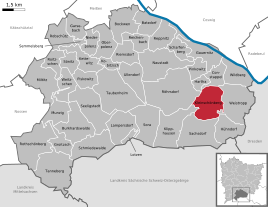Kleinschönberg
|
Kleinschönberg
Community Klipphausen
Coordinates: 51 ° 5 ′ 6 ″ N , 13 ° 33 ′ 50 ″ E
|
|
|---|---|
| Height : | 230 m above sea level NN |
| Residents : | 119 |
| Incorporation : | July 1, 1950 |
| Incorporated into: | Weistropp |
| Postal code : | 01665 |
| Area code : | 03521 |
|
Location of the Kleinschönberg district in Klipphausen
|
|
Kleinschönberg is a district of the village of Klipphausen in the municipality of the same name in the district of Meißen , Saxony .
geography
Kleinschönberg is located in the part of the Meißner highlands known as Wilsdruffer Land . The village is surrounded by the other districts belonging to Klipphausen: Röhrsdorf in the west, Hartha in the northwest, Constappel in the north, Wildberg in the northeast, Weistropp in the east, Hühndorf in the south and Sachsdorf and Klipphausen itself in the southwest. The city limits of the state capital Dresden run about two kilometers east of the Kleinschönberg location .
Agricultural plateaus surround the village. The center is located on the orographic left slope to the valley of the Prinzbach, which flows north of Kleinschönberg into the Wilde Sau . It is a well-preserved street green village that is laid out in an east-west direction. The road bordering the Anger to the south is called “Schmiedeberg”, the northern one is called “Sonnenlehne”.
Hartsteinwerke Kleinschönberg operates a ten-hectare quarry on the Meßweg in the southwest of the corridor, about one kilometer from the town center. They mine the Kleinschönberger Syenite , a brown to reddish natural stone.
history
The place was first mentioned in 1350 as "Schonenberg". It had to be distinguished from places of the same name early on. It is called "Schonberg (penes Constapil )" in 1378 , "Schonberg an der Elbe " in 1465 , although it is more than two kilometers away from this, and "Schonbergk" in 1587. In 1791 it was mentioned as "Klein Schönberg", especially to distinguish it from the Rothschönberg, twelve kilometers to the west .
The village, which possibly emerged from a Slavic nucleus, was predominantly settled for centuries by farmers who farmed the 332 hectare strip of land similar to mining. In the 16th century, the landlords were the owners of the Klipphausen manor , then in 1696 the owners of Gauernitz Castle . Kleinschönberg has always been a parish of Weistropp. In 1856 it belonged to the Wilsdruff court office and then came to the Meißen district administration , from which the district of the same name emerged. Kleinschönberg lost its independence on July 1, 1950 when it was incorporated into Weistropp, which in turn was incorporated into Klipphausen on January 1, 1994.
Population development
|
Personalities
- Olaf Böhme (1953–2019), German cabaret artist and actor, lived in Kleinschönberg
Others
Approximately in the center of the village there is a peace linden tree planted in 1648 (end of the Thirty Years War ).
The end point of the first Stoppomat system in the new federal states is at the quarry in Kleinschönberg . It is set up on the mountain route from Constappel to Kleinschönberg, on which a height difference of around 185 meters has to be overcome over a route length of approx. 4.5 kilometers. The operator is the cycling department of the Elbland Coswig-Meißen e. V.
Several buildings in the village are protected as cultural monuments (see list of cultural monuments in Kleinschönberg ).
literature
- Cornelius Gurlitt : Kleinschönberg. In: Descriptive representation of the older architectural and art monuments of the Kingdom of Saxony. 41. Issue: Administrative Authority Meißen-Land . CC Meinhold, Dresden 1923, p. 221.
Web links
- Kleinschönberg in the Digital Historical Directory of Saxony
Individual evidence
- ↑ nsm-neuber.de
- ↑ Municipalities 1994 and their changes since January 1, 1948 in the new federal states , Metzler-Poeschel publishing house, Stuttgart, 1995, ISBN 3-8246-0321-7 , publisher: Federal Statistical Office
- ↑ The Stoppomat is back in operation. In: sz-online.de. April 1, 2017. Retrieved April 24, 2017 .




